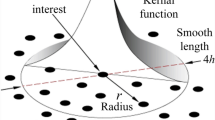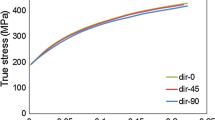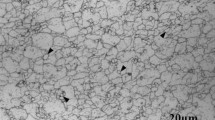Abstract
In the roller hemming process, the high-viscosity adhesive has affected the forming process of metal sheets, especially lightweight materials. However, the effect and mechanism are not clear. In this paper, the hemming adhesive is taken as a viscous Newtonian fluid. First of all, the pressure-viscosity effect in the model of parallel-panel squeeze is investigated, while the adhesive flow is simulated by smooth particle hydrodynamics (SPH) method, and the results are compared and verified by analytical solutions. Then, the roller hemming process of aluminum alloy sheet AA6106-T4 with adhesive is simulated by using the fluid-solid coupling method, while the adhesive is modeled by SPH and the aluminum alloy sheet is modeled by finite element method (FEM). The accuracy of the simulation model is verified by a comparison of roll-in/out in experiment and the effect and mechanism is studied based on the pressure-viscosity effect. The results show that adhesive thickness is the most important factor of the pressure-viscosity effect. The roll-in value of aluminum alloy sheet sample with 0.2-mm thick adhesive is relatively less than that without under the same conditions, and the roll-in of aluminum alloy sheet raises with an increase of the adhesive layer thickness. The evaluated roll-in/out of samples with different thickness of adhesive can obtain zero value theoretically after final hemming.





















Similar content being viewed by others
References
Muderrisoglu A, Murata M, Ahmetoglu M, Kinzel G, Altan T (1996) Bending, flanging and hemming of aluminum sheet-an experimental study. J Mater Process Technol 59(1-2):10–17
Aguilar JJ, Sanz M, Guillomia D, Lope M, Bueno I (2006) Analysis, characterization and accuracy improvement of optical coordinate measurement systems for car body assembly quality control. Int J Adv Manuf Technol 30(11-12):1174–1190
Zhang GH, Wu X, H SJ (2003) A study on fundamental mechanisms of warp and recoil in hemming. J Eng Mater Technol 123(4):436–441
Livatyali H, Muderrisoglu A, Ahmetoglu M, Akgeman N, Kinzel G, Altan T (2000) improvement of hem quality by optimizing flanging and pre-hemming operations using computer aided die design. J Mater Process Technol 98(1):41–52
Livatyali H, Laxhuber T, Altan T (2004) Experimental investigation of forming defects in flat surface-convex edge hemming. J Mater Process Technol 146(1):20–27
Livatyali H, Larris S (2004) Experimental investigation of forming defects in flat surface-convex edge hemming: roll, recoil and warp. J Mater Process Technol 153(1):913–919
Thuillier S, Maoût N, Manach P, Debois D (2008) Numerical simulation of the roller hemming process. J Mater Process Technol 198(1):226–233
Hu X, Zhao YX, Huang S, Li SH, Lin ZQ (2012) Numerical analysis of the roller hemming process. Int J Adv Manuf Technol 62(5-8):543–550
Hu X, Lin ZQ, Li SH, Zhao YX (2011) Fracture limit prediction for roller hemming of aluminum alloy sheet. Mater Des 31(3):1410–1416
Lin G, Iyer K, Hu J, Cai W, Marin SP (2005) A computational design-of-experiments study of hemming processes for automotive aluminium alloys. Proc IMechE B J Eng Manuf 219(10):711–722
Lin G, Li J, Hu S, Cai W (2007) A computational response surface study of three-dimensional aluminum hemming using solid-to-shell mapping. J Manuf Sci Eng 129(2):360–368
Arroyo A, Pérez I, Gutierrez M, Bahillo J, Toja H (2010) Roller hemming: a new simulation model for the automotive industry. In: Proceedings of the 36th International MATADOR Conference. London, pp 83–86
Maoût N, Manach P, Thuillier S (2012) Influence of prestrain on the numerical simulation of the roller hemming process. J Mater Process Technol 212(2):450–457
Calabrese L, Galtieri G, Borsellino C, Di Bella G, Proverbio E (2016) Durability of hybrid clinch-bonded steel/aluminum joints in salt spray environment. Int J Adv Manuf Technol 87(9-12):3137–3147
Svensson M, Mattiasson K (2002) Three-dimensional simulation of hemming with the explicit FE-Method. J Mater Process Technol 128(1-3):142–154
Sigvant M, Mattiasson K (2005) FE-simulation of hemming in the automotive industry. Am Inst Phys 778:675–680
Zhu WF, Xu C, Zeng L (2010) Coupled finite element analysis of MIG welding assembly on auto-body high-strength steel panel and door hinge. Int J Adv Manuf Technol 51(5):551–559
Zhu WF, Zhou JQ (2010) Optimal method for auto-body closure panel fitting using Hausdorff distance criteria. Int J Adv Manuf Technol 48(9-12):1019–1029
Moura M, Gonçalves J, Chousal J, Campilho R (2008) Cohesive and continuum mixed-mode damage models applied to the simulation of the mechanical behaviour of bonded joints. Int J Adhes Adhes 28(8):419–426
Laun HM, Rady M, Hasager O (1999) Analytical solutions for squeeze flow with partial wall slip. J Non-Newtonian Fluid Mech 81(1-2):1–15
Burka P, Liu X, Thompson M (2013) Modelling of adhesive bonding for aircraft structures applying the insertion squeeze flow method. Compos Part B 50:247–252
Geng XL, Dow W, Deng JY, Yue ZF (2017) Simulation of the cutting sequence of AISI 316 L steel based on the smoothed particle hydrodynamics method. Int J Adv Manuf Technol 89(1-4):643–650
Guo XG, Wei YJ, Jin ZJ, Guo DM (2013) A numerical model for optical glass cutting based on SPH method. Int J Adv Manuf Technol 68(5-8):1277–1283
Lucy L (1977) A numerical approach to testing of the fission hypothesis. Astron J 82(12):1013–1024
Gingold R, Monaghan J (1977) Smoothed particle hydrodynamics: theory and application to non-spherical stars. Mon Not R Astron Soc 181(3):375–389
Oger G, Doring M, Alessandrini B, Ferrant (2006) Two-dimensional SPH simulations of wedge water entries. J Comp Physiol 213(2):803–822
Liu GR, Liu M (2003) Smoothed particle hydrodynamics: a meshfree particle method. World Scientific, Singapore
Wang JM, Gao N, Gong WJ (2010) Abrasive waterjet machining simulation by SPH method. Int J Adv Manuf Technol 50(1-4):227–234
Cleary PW, Monaghan J (1999) Conduction modelling using smoothed particle hydrodynamics. J Comp Physiol 148(1):227–264
Iwata T, Iwata N (2018) A novel approach of springback analysis using a drawbead and a die shoulder database in sheet metal forming simulation. Int J Adv Manuf Technol 95(9-12):3535–3547
Author information
Authors and Affiliations
Corresponding author
Additional information
Publisher’s note
Springer Nature remains neutral with regard to jurisdictional claims in published maps and institutional affiliations.
Rights and permissions
About this article
Cite this article
Jianjun, L., Wenfeng, Z. Numerical simulation of the roller hemming process based on pressure-viscosity effect. Int J Adv Manuf Technol 105, 1023–1039 (2019). https://doi.org/10.1007/s00170-019-04237-5
Received:
Accepted:
Published:
Issue Date:
DOI: https://doi.org/10.1007/s00170-019-04237-5




